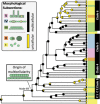Cyanobacteria and the Great Oxidation Event: evidence from genes and fossils
- PMID: 26924853
- PMCID: PMC4755140
- DOI: 10.1111/pala.12178
Cyanobacteria and the Great Oxidation Event: evidence from genes and fossils
Abstract
Cyanobacteria are among the most ancient of evolutionary lineages, oxygenic photosynthesizers that may have originated before 3.0 Ga, as evidenced by free oxygen levels. Throughout the Precambrian, cyanobacteria were one of the most important drivers of biological innovations, strongly impacting early Earth's environments. At the end of the Archean Eon, they were responsible for the rapid oxygenation of Earth's atmosphere during an episode referred to as the Great Oxidation Event (GOE). However, little is known about the origin and diversity of early cyanobacterial taxa, due to: (1) the scarceness of Precambrian fossil deposits; (2) limited characteristics for the identification of taxa; and (3) the poor preservation of ancient microfossils. Previous studies based on 16S rRNA have suggested that the origin of multicellularity within cyanobacteria might have been associated with the GOE. However, single-gene analyses have limitations, particularly for deep branches. We reconstructed the evolutionary history of cyanobacteria using genome scale data and re-evaluated the Precambrian fossil record to get more precise calibrations for a relaxed clock analysis. For the phylogenomic reconstructions, we identified 756 conserved gene sequences in 65 cyanobacterial taxa, of which eight genomes have been sequenced in this study. Character state reconstructions based on maximum likelihood and Bayesian phylogenetic inference confirm previous findings, of an ancient multicellular cyanobacterial lineage ancestral to the majority of modern cyanobacteria. Relaxed clock analyses provide firm support for an origin of cyanobacteria in the Archean and a transition to multicellularity before the GOE. It is likely that multicellularity had a greater impact on cyanobacterial fitness and thus abundance, than previously assumed. Multicellularity, as a major evolutionary innovation, forming a novel unit for selection to act upon, may have served to overcome evolutionary constraints and enabled diversification of the variety of morphotypes seen in cyanobacteria today.
Keywords: atmosphere; divergence time estimation; early life; genomics; major transition.
Figures






Similar articles
-
Timing the Evolutionary Advent of Cyanobacteria and the Later Great Oxidation Event Using Gene Phylogenies of a Sunscreen.mBio. 2019 May 21;10(3):e00561-19. doi: 10.1128/mBio.00561-19. mBio. 2019. PMID: 31113897 Free PMC article.
-
The Archean origin of oxygenic photosynthesis and extant cyanobacterial lineages.Proc Biol Sci. 2021 Sep 29;288(1959):20210675. doi: 10.1098/rspb.2021.0675. Epub 2021 Sep 29. Proc Biol Sci. 2021. PMID: 34583585 Free PMC article.
-
Evolution of multicellularity coincided with increased diversification of cyanobacteria and the Great Oxidation Event.Proc Natl Acad Sci U S A. 2013 Jan 29;110(5):1791-6. doi: 10.1073/pnas.1209927110. Epub 2013 Jan 14. Proc Natl Acad Sci U S A. 2013. PMID: 23319632 Free PMC article.
-
The role of biology in planetary evolution: cyanobacterial primary production in low-oxygen Proterozoic oceans.Environ Microbiol. 2016 Feb;18(2):325-40. doi: 10.1111/1462-2920.13118. Epub 2015 Dec 21. Environ Microbiol. 2016. PMID: 26549614 Free PMC article. Review.
-
Geological evidence of oxygenic photosynthesis and the biotic response to the 2400-2200 ma "great oxidation event".Biochemistry (Mosc). 2014 Mar;79(3):165-77. doi: 10.1134/S0006297914030018. Biochemistry (Mosc). 2014. PMID: 24821442 Review.
Cited by
-
The origin and impeded dissemination of the DNA phosphorothioation system in prokaryotes.Nat Commun. 2021 Nov 4;12(1):6382. doi: 10.1038/s41467-021-26636-7. Nat Commun. 2021. PMID: 34737280 Free PMC article.
-
Cyanotoxins, biosynthetic gene clusters, and factors modulating cyanotoxin biosynthesis.World J Microbiol Biotechnol. 2023 Jul 3;39(9):241. doi: 10.1007/s11274-023-03652-x. World J Microbiol Biotechnol. 2023. PMID: 37394567 Review.
-
A Genetic Toolbox for the New Model Cyanobacterium Cyanothece PCC 7425: A Case Study for the Photosynthetic Production of Limonene.Front Microbiol. 2020 Sep 18;11:586601. doi: 10.3389/fmicb.2020.586601. eCollection 2020. Front Microbiol. 2020. PMID: 33042102 Free PMC article.
-
Solar energy conversion by photosystem II: principles and structures.Photosynth Res. 2023 Jun;156(3):279-307. doi: 10.1007/s11120-022-00991-y. Epub 2023 Feb 24. Photosynth Res. 2023. PMID: 36826741 Free PMC article. Review.
-
Post-translational amino acid conversion in photosystem II as a possible origin of photosynthetic oxygen evolution.Nat Commun. 2022 Jul 21;13(1):4211. doi: 10.1038/s41467-022-31931-y. Nat Commun. 2022. PMID: 35864123 Free PMC article.
References
-
- Altermann, W. and Schopf, J. W. 1995. Microfossils from the Neoarchean Campbell Group, Griqualand West Sequence of the Transvaal Supergroup, and their paleoenvironmental and evolutionary implications. Precambrian Research, 75, 65–90. - PubMed
-
- Amard, B. and Bertrand‐Sarfati, J. 1997. Microfossils in 2000 Ma old cherty stromatolites of the Franceville Group, Gabon. Precambrian Research, 81, 197–221.
-
- Anbar, A. D. , Duan, Y. , Lyons, T. W. , Arnold, G. L. , Kendall, B. , Creaser, R. A. , Kaufman, A. J. , Gordon, G. W. , Scott, C. , Garvin, J. and Buick, R. 2007. A whiff of oxygen before the great oxidation event? Science, 317, 1903–1906. - PubMed
-
- Aronesty, E. 2013. Comparison of sequencing utility programs. The Open Bioinformatics Journal, 7, 1–8.
Grants and funding
LinkOut - more resources
Full Text Sources
Other Literature Sources
Molecular Biology Databases
